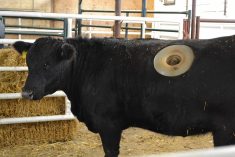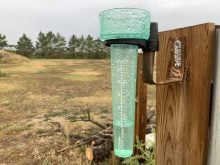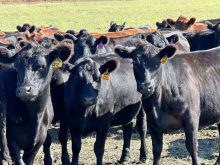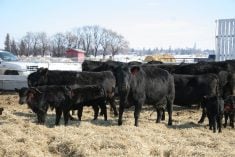It was supposed to be the year to grow the cattle herd — but Mother Nature and dry conditions across Alberta have changed all that.
A lack of hay and pasture makes for tough choices and some are taking cattle to market.
Viking Hutterite Colony usually buys calves, backgrounds them until spring, and then turns them out to pasture. But earlier this summer, the colony sold 350 yearlings.
“Because of the drought situation, we weren’t able to put them out on pasture,” said farm manager Paul Wipf. “But we did do OK and got good money for our cattle. We sold them early enough, and somebody must have had some pasture.”
Read Also

Moo translator and methane measures: There’s an app for that
Dalhousie University researchers use artificial intelligence to create new dairy farm apps that analyze cattle sounds and measure methane.
Now Wipf is fielding calls from cattle producers in his area looking to see if he has pasture available.
“I know that there’s going to be a big shortage of hay,” he said. “Guys are not panicking yet because they’re still hoping for rain. What they’re doing now is a heavy cull and that’s what’s coming to the market now.”
- More on the Alberta Farmer: More cattle heading to market as drought worsens
Rob Somerville, a producer from Endiang and a delegate with Alberta Beef Producers, is trying to avoid reducing his herd this year.
“From an industry standpoint, that’s not what we want to see,” he said. “You have to have that cow factory going to meet the demand domestically in Canada, and for our international markets. If you don’t have the cows, you’re not in the game.”
However, Somerville, who has 300 head, knows that producers have to make difficult choices and provide for their cows. He’s still hoping for rain, and says that what happens with the weather in the next month could still make a difference. Rain, of course is severely needed, but a frost in August could affect grain crops and make more feed available for cows.

“From a cattle guy’s standpoint, that’s a faint hope, and from a grain guy’s standpoint, it’s a real fear,” said Somerville, who runs a mixed farm with wife Laurie, son Stuart, and daughter-in-law Kayla.
He’s already decided his grain crops will go for feed, but rain is needed if they’re to be silaged.
“They are late, and they have not been advancing properly due to a lack of rainfall — there is a low probability that they will mature in time before a normal frost,” said Somerville.
“An early frost would spell an end to those crops. What we’ll end up with is totally anyone’s guess. There is no subsoil moisture, no spare moisture, and no assurance of anything right now.”
Somerville, who has hay and pasture insurance, said he’s determined to keep the cows, but he’s going to have to be creative about his feed this year.
“It won’t be a hay diet; it will be alternative feeds,” he said.
Somerville and his family went into drought mode in May, deciding to seed crops that might do better in a dry year.
“On our grain side, we were a little more careful with what we spent. If we had been more optimistic about the moisture situation, we would have gone all out on the inputs.”
















